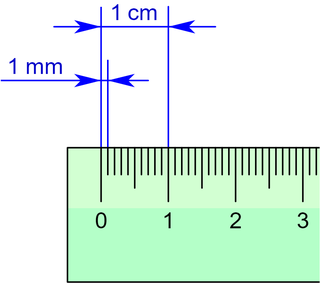
The millimetre or millimeter is a unit of length in the metric system, equal to one thousandth of a metre, which is the SI base unit of length. Therefore, there are one thousand millimetres in a metre. There are ten millimetres in a centimetre.

A shoe size is an indication of the fitting size of a shoe for a person.

The giant house spider has been treated as either one species, under the name Eratigena atrica, or as three species, E. atrica, E. duellica and E. saeva. As of April 2020, the three species view was accepted by the World Spider Catalog. They are among the largest spiders of Central and Northern Europe. They were previously placed in the genus Tegenaria. In 2013, they were moved to the new genus Eratigena as the single species Eratigena atrica. In 2018, the three separate species were restored. The bite of these species does not pose a threat to humans or pets, and they are generally reluctant to bite, preferring instead to hide or escape.

Juniperus osteosperma is a shrub or small tree reaching 3–6 m tall. It is native to the southwestern United States, in Utah, Nevada, Arizona, western New Mexico, western Colorado, Wyoming, southern Montana, southern Idaho and eastern California. It grows at moderate altitudes of 1,300–2,600 metres (4,300–8,500 ft), on dry soils, often together with Pinus monophylla.

The common furniture beetle or common house borer is a woodboring beetle. In the larval stage it bores in wood and feeds upon it. Adult Anobium punctatum measure 2.7–4.5 millimetres (0.11–0.18 in) in length. They have brown ellipsoidal bodies with a prothorax resembling a monk's cowl .

Ptiliidae is a family of very tiny beetles with a cosmopolitan distribution. This family contains the smallest of all beetles, with a length when fully grown of 0.3–4.0 millimetres (0.01–0.16 in). The weight is approximately 0.4 milligrams. They are colloquially called featherwing beetles, because the hindwings are narrow and feathery. The eggs are very large in comparison to the adult female so only one egg at a time can be developed and laid. Parthenogenesis is exhibited by several species.
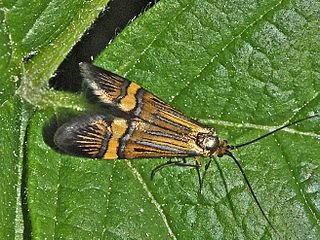
The longhorn moth or yellow-barred long-horn is a diurnal lepidopteran from the moths family Adelidae.
Juniperus tibetica, the Tibetan juniper, is a species of juniper, native to western China in southern Gansu, southeastern Qinghai, Sichuan, and Tibet Autonomous Region, where it grows at high to very high altitudes of 2,600–4,800 metres (8,500–15,700 ft). This species may possess the highest elevation treeline in the world.
The Nigerian mole-rat is a species of rodent in the family Bathyergidae. It is found in northern Nigeria and Cameroon. A colonial, subterranean species, its natural habitats are tropical dry lowland grassland, riverside woodland and rocky places.

Fumibotys is a monotypic moth genus of the family Crambidae which was described by Eugene G. Munroe in 1976. Its single species, Fumibotys fumalis, the mint root borer moth, described by Achille Guenée in 1854, is found in most of North America.
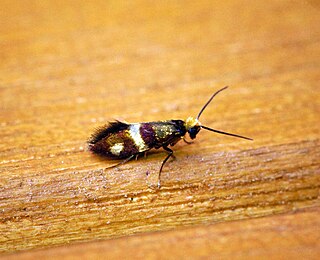
Micropterix aglaella is a species of moth belonging to the family Micropterigidae.It is found in southern France, south-western Switzerland and northern Italy.
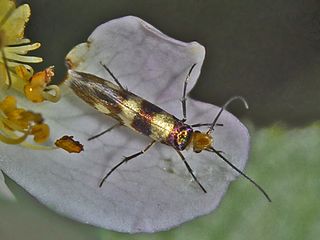
Micropterix allionella is a moth of the family Micropterigidae. It was described by Johan Christian Fabricius in 1794.
Micropterix corcyrella is a species of moth belonging to the family Micropterigidae. It was described by Walsingham, Lord Thomas de Grey, in 1919. It is found in Slovenia, Serbia and Montenegro, North Macedonia, Bulgaria and Greece.
Micropterix fenestrellensis is a species of moth belonging to the family Micropterigidae. It was described by John Heath and T. Kaltenbach in 1984. It is known from Italy.
Micropterix rablensis is a species of moth belonging to the family Micropterigidae that was described by Zeller in 1868. It is probably restricted to Carinthia in Austria and to the adjacent areas of Styria in Austria and Italy and potentially of Slovenia. Its Croatian, Romanian and French existence is doubtful.
Micropterix trinacriella is a species of moth belonging to the family Micropterigidae that was described by Michael A. Kurz, Hans Christof Zeller-Lukashort and Marion E. Kurz in 1997. It is only known from the area near the northern shore of Sicily, as well as in the surrounding of Mount Etna.
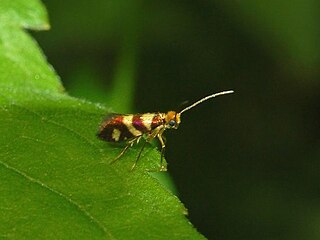
Micropterix tuscaniensis is a species of moth belonging to the family Micropterigidae. It was described by Heath in 1960. It is only known from central and southern Italy, where it has been found in the provinces of Tuscany, Calabria, Apulia and Basilicata. However, it is probably distributed throughout the whole of mainland Italy, except for the Alps.
Micropterix renatae is a species of moth belonging to the family Micropterigidae that was described by Michael A. Kurz, Marion E. Kurz and Hans Christof Zeller-Lukashort in 1997. It is known from the Ligurian Alps, as well as the northern Apennine Mountains.

The 7.92×33mm Kurz is a rimless bottlenecked intermediate rifle cartridge developed in Nazi Germany prior to and during World War II, specifically intended for development of the Sturmgewehr 44. The ammunition is also referred to as 7.9mm Kurz, 7.9 Kurz, 7.9mmK, or 8×33 Polte. The round was developed as a compromise between the longer 7.92×57mm full-power rifle cartridge and the 9×19mm Parabellum pistol cartridge, and is the first mass-used intermediate cartridge in the world.

Copelatus chevrolati is a species of diving beetle. It is part of the genus Copelatus in the subfamily Copelatinae of the family Dytiscidae. It was described by Aubé in 1838. There are two described subspecies: C. c. chevrolati and C. c. renovatus.












